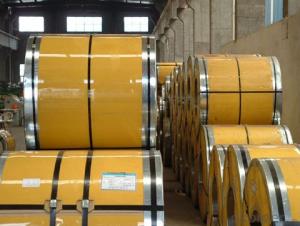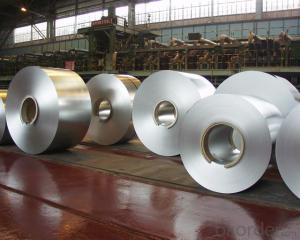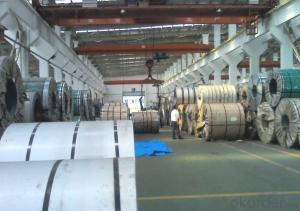Nickel Plated Copper Strips
- Loading Port:
- China Main Port
- Payment Terms:
- TT OR LC
- Min Order Qty:
- -
- Supply Capability:
- -
OKorder Service Pledge
OKorder Financial Service
You Might Also Like
Specifications
nickel plated copper strips
1. Purity: more than 99.7%
2. Strip Thickness: 0.05mm above
3. Resistance to corrosion in acid
nickel plated copper strips
Grade | Ni201 |
Standard | ASTM B162 |
Size | T0.05-0.5mm×W250mm×coil Slitting the width according to the requirements of customers’ |
Application | Metallurgy, electronics, chemical, petroleum, pharmaceutical, aerospace and other |
We supply Pure Nickel strip, the pure nickel strip has good mechanical properties over a wide range of temperature and excellent resistance to corrosive.
We could provide SGS test report and RoHs report.
Welcome to place a sample order.
- Q:What are the factors that affect the surface finish of steel strips?
- Several factors can affect the surface finish of steel strips. These factors include: 1. Steel composition: The chemical composition of the steel strip can have a significant impact on its surface finish. Elements such as carbon, silicon, and sulfur can influence the appearance and texture of the surface. 2. Surface preparation: The surface of the steel strip must be properly prepared before any finishing processes are applied. Factors such as cleaning, degreasing, and descaling can affect the overall finish of the strip. 3. Rolling processes: The rolling process used to manufacture the steel strip can impact its surface finish. Factors such as rolling temperature, speed, and pressure can influence the appearance and texture of the surface. 4. Lubrication: During the rolling process, lubricants are often used to reduce friction and prevent surface defects. The type and amount of lubrication can affect the surface finish of the steel strip. 5. Annealing process: Annealing is a heat treatment process that can affect the microstructure of the steel strip, which in turn can impact its surface finish. Factors such as annealing temperature and time can influence the appearance and texture of the surface. 6. Coating or plating processes: If the steel strip is coated or plated with another material, the quality and application of the coating or plating can affect the final surface finish. Factors such as thickness, adhesion, and uniformity of the coating can influence the appearance and texture of the surface. 7. Handling and storage: Improper handling or storage of the steel strip can lead to surface damage or contamination. Factors such as scratches, dents, or exposure to corrosive substances can affect the overall surface finish. Overall, a combination of these factors can determine the surface finish of steel strips, and manufacturers need to carefully consider and control these variables to achieve the desired appearance and quality.
- Q:What are the factors affecting the cost of steel strips?
- There are several factors that can affect the cost of steel strips. Firstly, the price of raw materials used in the production of steel strips is a significant factor. If the cost of iron ore, coal, and other materials used in steelmaking increases, it will have a direct impact on the cost of steel strips. Another important factor is the demand and supply dynamics of the steel industry. If there is a high demand for steel strips and limited supply, the cost will likely increase. On the other hand, if the demand is low and there is excess supply, it could lead to a decrease in prices. Fluctuations in energy prices can also affect the cost of steel strips. The steel manufacturing process requires a significant amount of energy, and any increase in energy costs can raise the overall production cost, thus impacting the price of steel strips. Transportation costs play a role as well. If the steel strips need to be transported over long distances, the cost of shipping and logistics can add to the overall cost. Additionally, the level of competition in the steel industry can influence the cost of steel strips. If there are many steel manufacturers competing for market share, they may lower their prices to attract customers. Conversely, if there are fewer competitors, they may have more pricing power, resulting in higher costs. Lastly, government policies and regulations can impact the cost of steel strips. Tariffs, taxes, and trade restrictions can increase the cost of imported steel strips, while subsidies or incentives can affect the cost of domestically produced steel. In summary, the factors affecting the cost of steel strips include raw material prices, demand and supply dynamics, energy costs, transportation costs, competition, and government policies. These factors can fluctuate over time, leading to changes in the cost of steel strips.
- Q:Can steel strips be used for making tools or machinery parts?
- Yes, steel strips can be used for making tools or machinery parts. Steel strips are versatile and commonly used in various industries for their strength, durability, and ease of fabrication. They can be cut, shaped, and formed into specific tool or machinery parts, providing the necessary strength and reliability required for these applications.
- Q:How are steel strips used in automotive industry?
- Steel strips are widely used in the automotive industry for a variety of applications. One of the main uses of steel strips is in the manufacturing of car bodies and frames. These strips are often formed and welded together to create the structural components of a vehicle, providing strength and durability. Additionally, steel strips are used in the production of various automotive components such as suspension systems, exhaust systems, and engine parts. These strips can be shaped and manipulated to meet specific requirements and are known for their excellent mechanical properties, including high tensile strength and resistance to corrosion. Moreover, steel strips are used in the fabrication of automotive springs, which are vital for ensuring the smooth operation of vehicles. Springs made from steel strips provide the necessary support and stability, allowing the suspension system to absorb shocks and vibrations, thus improving overall driving comfort. Furthermore, steel strips are employed in the production of automotive fasteners, such as bolts, nuts, and screws, which are essential for holding various parts together. These fasteners need to be strong and reliable, and steel strips provide the necessary strength and integrity for secure connections. In summary, steel strips play a crucial role in the automotive industry, being used in the manufacturing of car bodies and frames, as well as various components such as suspension systems, exhaust systems, springs, and fasteners. Their exceptional mechanical properties make them an ideal material choice, ensuring safety, durability, and overall performance of vehicles.
- Q:How are steel strips used in the production of metal shelving?
- Steel strips are used in the production of metal shelving to provide structural support and stability. These strips are typically shaped and formed into brackets or supports that reinforce the shelves, ensuring they can hold heavy loads without bending or collapsing. The strips may also be used to create the frame or framework of the shelving unit, providing a strong and durable structure.
- Q:How are steel strips used in manufacturing?
- Steel strips are widely used in manufacturing for various purposes. One common application is in the production of metal components and parts. These strips are often used as raw materials to create various shapes and sizes of metal parts through processes like stamping, bending, or forming. Steel strips are also commonly used in the automotive industry for manufacturing various parts such as car body panels, brackets, and reinforcements. They provide strength, durability, and corrosion resistance, making them ideal for withstanding the demanding conditions of automotive applications. Moreover, steel strips are extensively used in the production of appliances, machinery, and equipment. They are utilized in manufacturing components like gears, springs, valves, and connectors. The versatility of steel strips allows for the creation of intricate and precise parts that meet the specific requirements of different industries. Additionally, steel strips find applications in the construction industry. They are used for manufacturing structural components like beams, columns, and reinforcement bars. These strips offer high strength and load-bearing capacity, making them essential for constructing buildings, bridges, and other infrastructure projects. Furthermore, steel strips are used in the production of electrical and electronic devices. They are employed in manufacturing components such as transformers, generators, and electrical panels. The magnetic properties of certain steel alloys make them suitable for these applications. In summary, steel strips play a crucial role in the manufacturing industry. Their versatility, strength, and durability make them suitable for a wide range of applications. From automotive and construction to appliances and electronics, steel strips are essential in the production of various components and parts.
- Q:What are the benefits of using pre-painted steel strips?
- The benefits of using pre-painted steel strips include enhanced durability and corrosion resistance, reduced maintenance and painting costs, improved aesthetics, and efficient installation due to the ready-to-use nature of the pre-painted strips.
- Q:How are steel strips shaped and formed?
- Rolling is the process by which steel strips are shaped and formed. To achieve this, large steel billets or slabs are passed through a series of rolling mills. These mills apply pressure and force to the metal, transforming it into thin, flat strips. The rolling mills are equipped with rollers that gradually reduce the thickness of the steel strip at each stage. The process begins with heating the steel billet to a high temperature, making it more malleable. The hot billet is then fed into the first rolling mill, where it passes through a set of rollers that progressively decrease the strip's thickness. Afterward, the strip is cooled and transferred to the next rolling mill, where the process is repeated. Each rolling mill has a specific roll configuration designed to give the steel strip the desired shape and dimensions. This can include flat rolls, which evenly compress the strip to reduce thickness, or shaped rolls, which create specific cross-sectional profiles like round, square, or rectangular shapes. Once the desired shape is achieved, the steel strip may undergo additional processing to enhance its mechanical properties. Annealing or tempering can be employed, involving heating and cooling the strip to alter its microstructure and improve strength, ductility, and hardness. Aside from rolling, steel strips can also be formed using cold forming or stamping techniques. Cold forming shapes the steel strip at room temperature using dies or molds, commonly used for creating complex shapes and precise dimensions. On the other hand, stamping involves cutting or shaping the steel strip using a press with a die specifically designed for the desired shape. In summary, the shaping and forming of steel strips combine heating, rolling, and other forming techniques to achieve the desired shape, dimensions, and mechanical properties. These processes play a crucial role in the manufacturing of various steel products, including automotive parts, construction materials, and household appliances.
- Q:What's the difference between strip 235 and 235b?
- Q235 is Q235a, Q235 material according to the sulphur and phosphorus content from high to low is divided into ABCD four grades, grade a sulfur phosphorus was the highest relative performance (welding, plasticity) is the worst, D performance is the highest, the lowest content of parathion
- Q:How are steel strips processed further for specific applications?
- Steel strips are processed further for specific applications through various methods such as cutting, shaping, and heat treatment. These processes help to achieve the desired dimensions and properties required for different applications. Additionally, surface treatments like coating or plating may be applied to enhance the steel's corrosion resistance or aesthetic appearance.
1. Manufacturer Overview |
|
|---|---|
| Location | |
| Year Established | |
| Annual Output Value | |
| Main Markets | |
| Company Certifications | |
2. Manufacturer Certificates |
|
|---|---|
| a) Certification Name | |
| Range | |
| Reference | |
| Validity Period | |
3. Manufacturer Capability |
|
|---|---|
| a)Trade Capacity | |
| Nearest Port | |
| Export Percentage | |
| No.of Employees in Trade Department | |
| Language Spoken: | |
| b)Factory Information | |
| Factory Size: | |
| No. of Production Lines | |
| Contract Manufacturing | |
| Product Price Range | |
Send your message to us
Nickel Plated Copper Strips
- Loading Port:
- China Main Port
- Payment Terms:
- TT OR LC
- Min Order Qty:
- -
- Supply Capability:
- -
OKorder Service Pledge
OKorder Financial Service
Similar products
New products
Hot products
Related keywords




























